This week #BiciBus activists from Barcelona hosted fellow Bike Bus leaders from around the world, and they came together for the first ever Bike Bus Summit (link). Since 2021, the Bike Bus movement has exploded, and it probably is the most exciting thing happening in active transportation today. While Bike Bus has been around for over a decade, the number of Bike Buses taking children to school has grown exponentially in the last two years, in part due to social media and viral videos showing swarms of kids cycling together. Bike Bus is fun, energetic, and inspiring. Seeing Bike Bus online has motivated children, parents and teachers around the world to organize their own initiatives.
Here I reflect on what I learned from the Bike Bus Summit, to complement what has been shared in the official press release (link).
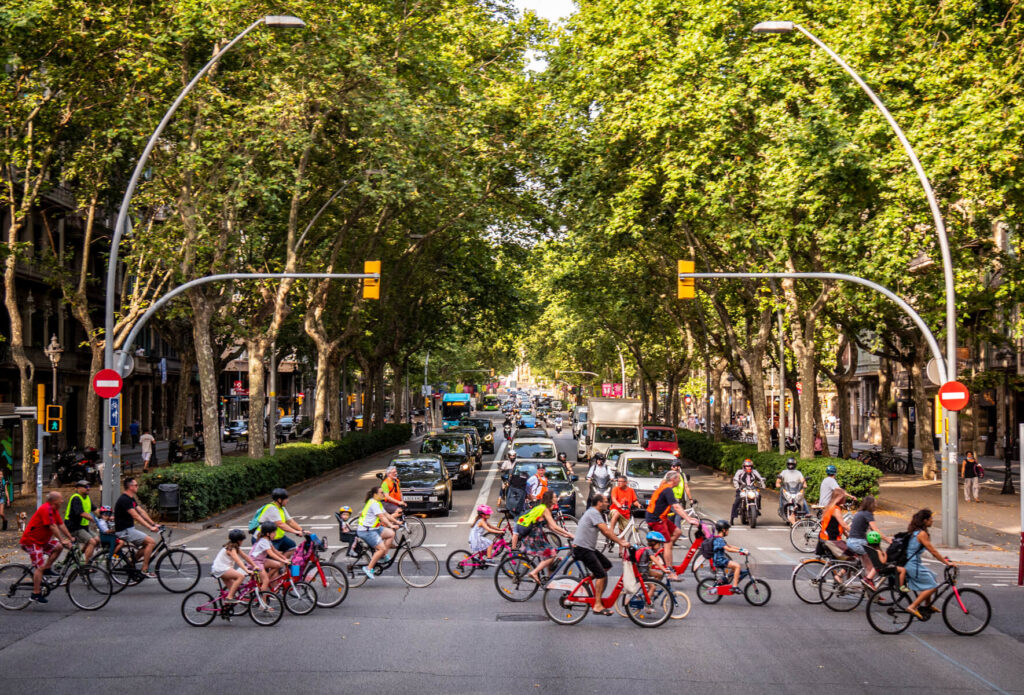
We should think more carefully about child age
One key insight is that Bike Bus attracts younger children age 6-8. These are early primary school children in the 1st, 2nd and 3rd grade. The Shawlands Bike Bus in Glasgow is comprised of children age 6-7 with a few around 10. Our global survey of Bike Bus leaders gave an estimated age of 7.8, which we round up to age 8. Some Bike Bus even report an average age of 5.
It is an age at which kids have loads of fun cycling together with friends and their parents. I would be interested in learning more about the development stage of children age 6-8 and to think about why this age group is more attracted to Bike Bus.
This is a notable result because it is not the age at which researchers study the cycling behaviour of children. Nor is it the age at which may cycling programs aim to train kids cycling habits. Most studies that examine children cycling to school are around age 10, or older.
Researchers and cycle trainers target older children age 10-13 because it is easier for them to answer surveys and respond to instructions. In short, it is easier for the researchers and trainers, but not necessarily the best timing for the kids. In contrast, with children age 6 to 8 it is more difficult to work in a structured format, but something suggests that this is a critical age for the BiciBús movement.
If these preliminary results hold, researchers and cycling advocates for kids might be well served to study children at a younger age. Of course, there are challenges associated with this shift in age group, but it is something that we should think about more carefully as a movement and as advocates. How can we ensure that the younger children stay involved in BiciBús as they get older? We heard stories about how older children stop going to BiciBús because it is too slow for them. Older children aged 10-13, especially boys, like to start to race. How do we make the speed compatible with the needs of the younger children? Each age group has different needs and we need to think about how to accommodate everyone.
 We are beginning to see the scope of a Global BiciBús Movement
We are beginning to see the scope of a Global BiciBús Movement
The meeting also allowed our team to present some of our Bike Bus research. Gemma Simon-i-Mas, presented preliminary results from our global survey of the Bike Bus community. So far, we have survey responses from 109 Bike Buses in nine countries and we are aware of the existence of 45 more Bike Buses that have not answered our survey. While the survey is missing responses, we are beginning to see the scope, scale and diversity of the Bike Bus movement around the world. The average Bike Bus is a group of 16 children and 11 adults that travel to school together once a week, cycling a distance of 3 km and taking 21 minutes.
In addition to merely describing the movement, we are looking for patterns in what makes successful Bike Buses. For instance, the average distance is around 2-4 km. If it is much shorter, families will prefer to walk, while longer routes might be too long. We see the sweet spot around 2-4 kilometers.
Gareth from Shawlands Bike Bus made the good point that we should also be studying those groups that have started a Bike Bus but been unable to keep it going. What can we learn from the failed attempts? Might those experiences provide insights for those who want to create their own? Was it distance, slope or timing that made it difficult?
How do we scale and replicate? With volunteers or in a professional model?
A major question for the Bike Bus movement is how to scale. How do we inspire more families, schools and children to organize more Bike Buses? Here we had slightly different views, and this was a good thing.
Coach Sam Balto from Alameda Bike Bus in Portland, Oregon (USA) argued that cities and school districts can do much more. He pointed out that he was able to mobilize hundreds of children with only $500 USD that compensated parent volunteers with gift cards. He proposed a more professionalized model with paid staff devoted to promoting active transportation similar to the work that Megan is doing in Hood River.
Others are more skeptical of the professional model because it is top down. This view argues that it must be bottom up, led by parents and kids, or it will not succeed. While Sam has organized a highly successful BikeBus with a small budget, kids and families probably showed up because it was Coach Balto organizing it. His relationships and charisma made the difference. Volunteers provide the energy and charisma that brings in other families. Families and kids show up because they want to bike to school with their friends, or people they know. A volunteer led Bike Bus also generates the sense of ownership and stewardship. A top-down Bike Bus will never have this sense of ownership. This view argues that successful Bike Buses need strong personal relationships which is not easily obtained in top-down models that attempt to parachute into schools. The risk of a top-down approach is that it will miss the personal relationships, charisma and stewardship that comes from bottom-up volunteers and organizers.
And yet someone also made the point that volunteerism is not sustainable, nor equitable. This view argues for the need for formalization or institutionalization. Our research shows that the Bike Buses that have sustained themselves over the longest period of time have support from teachers, who stay at the school and are able to transmit the energy and enthusiasms from generation to generation of children and families. Volunteer led Bike Buses risk disappearing once the children grow up and the family leaves the school.
This view advocates for institutionalizing Bike Bus through active transportation budgets. The work in Oregon to change legislation and move transportation funding from conventional school buses to active bike buses illustrates exactly the type of work needed in this direction (link).
Coach Sam Balto also suggested that our focus should be on active transportation to school, not necessarily bikes. This view argues that we should not miss the bigger picture and wider aims that could also be achieved through walking school bus. Maybe bikes are not for everyone, and instead they choose to walk to school. However in some cities, and Barcelona in particular, the Bike Bus movement has been lifted by cycling advocates, making Bike Bus inseparable from cycling advocacy. It seems difficult to take the bike out of Bike Bus in this city. While in Portland it may make sense to frame Bike Bus as active transportation, in Barcelona, Bici Bus is about building a bikeable city. Listening to these contrasting views was enriching and helped us learn about what we share, and also how we are different.
BiciBús size, fun and efficiency
There are also differing views about how to balance group size, fun and efficiency. Genís from Barcelona’s BiciBús Eixample argues that we should not set expectations that small schools develop large bike buses. Instead, we should envision many smaller initiatives, with fewer children. On the other hand, the Bike Buses with more children is what is most fun. Participation with a large number of children provides energy and community. Smaller bike buses might be harder to sustain, unless there are clear practical benefits. Large biker buses can be less practical for families if they make up with it with fun. But if they are small, they need to be efficient and useful for families.
Ultimately, we all agree that in our ideal city, Bike Bus would not be necessary because everyone would be able to bike to school on their own.
Inspiring Stories
I found the story of Shawlands Bike Bus (@BikeBusShaw) particularly inspiring. A family from Glasgow visited Copenhagen and wondered why kids in their community could not bike to school. When they returned, they teamed up with several families to start their bike bus. They lived close to one another, making the logistics easy. For several weeks it was just them, a small group, riding to school. Then the group grew. More, and more joined. Then the media came, and soon they became the darling citizen initiative of the city. They worked with community police to support them. The city gave them a device that would change traffic lights green to give them priority through a major intersection. Public officials reached out to the organizers to ask how they more Bike Buses could be created. The city set the goal of creating 23 bike buses in 2023, one for each of the 23 neighborhoods of Glasgow.
The Barcelona Declaration
A major outcome of the Bike Bus Summit was the Barcelona Declaration. Rob from Bike Bus Worcester (@BikeWorcester), led us through the process to craft this strong statement about our collective work and vision:
#BikeBus is joy and freedom. Community bike rides to school make kids happier, more awake and ready to learn. Our community becomes more connected and resilient. We demonstrate that our streets can be for children too. As a #BikeBus community, we demand that our political leaders prioritize urban space and resources for child friendly, healthy and safer streets.
Bike Bus Summit, March 2023
- Alameda Bike Bus Oregon, USA Sam
- BiciBús Barcelona Barcelona Carmen, Chris, Diana, Genís, Jaume, Laura Marc, Mireia, Rosa
- BiciBus Frankfurt Germany Klaus, Simone
- BiciBús Online Catalonia Eduard
- BACC Catalonia Marta
- Bike Worcester England Rob
- Hood River Oregon, USA Megan
- ISGlobal Barcelona Monica
- Kidical Mass Koln, Germany Simone
- Ride To Radnor Cardiff, Wales Kane, Peter, Eoghan
- Shawlands Bike Bus Glasgow, Scotland Gareth, Jo, Camille, Sean, Katherine
- Univ. Aut de Barcelona Barcelona Jordi, Gemma, Anna
- Univ. Barcelona Barcelona Ainhara
- Univ. Strathclyde Glasgow, Scotland Dee, James
 It is important to recognize that this was only a small handful the organizers and activists that have pushed this cause. We were the fortunate ones, able to travel or take a Thursday afternoon off work to share our passion for safer streets for kids. Key friends and supporters were missing from the event, leaving us thinking about how we might want to organize our next gathering.
It is important to recognize that this was only a small handful the organizers and activists that have pushed this cause. We were the fortunate ones, able to travel or take a Thursday afternoon off work to share our passion for safer streets for kids. Key friends and supporters were missing from the event, leaving us thinking about how we might want to organize our next gathering.
Klaus and Simone from BiciBus Frankfurt volunteered immediately to organize the next workshop in Frankfurt in 2024. Seeing how quickly we are talking about next year made me realize that this was truly the beginning of a global network.
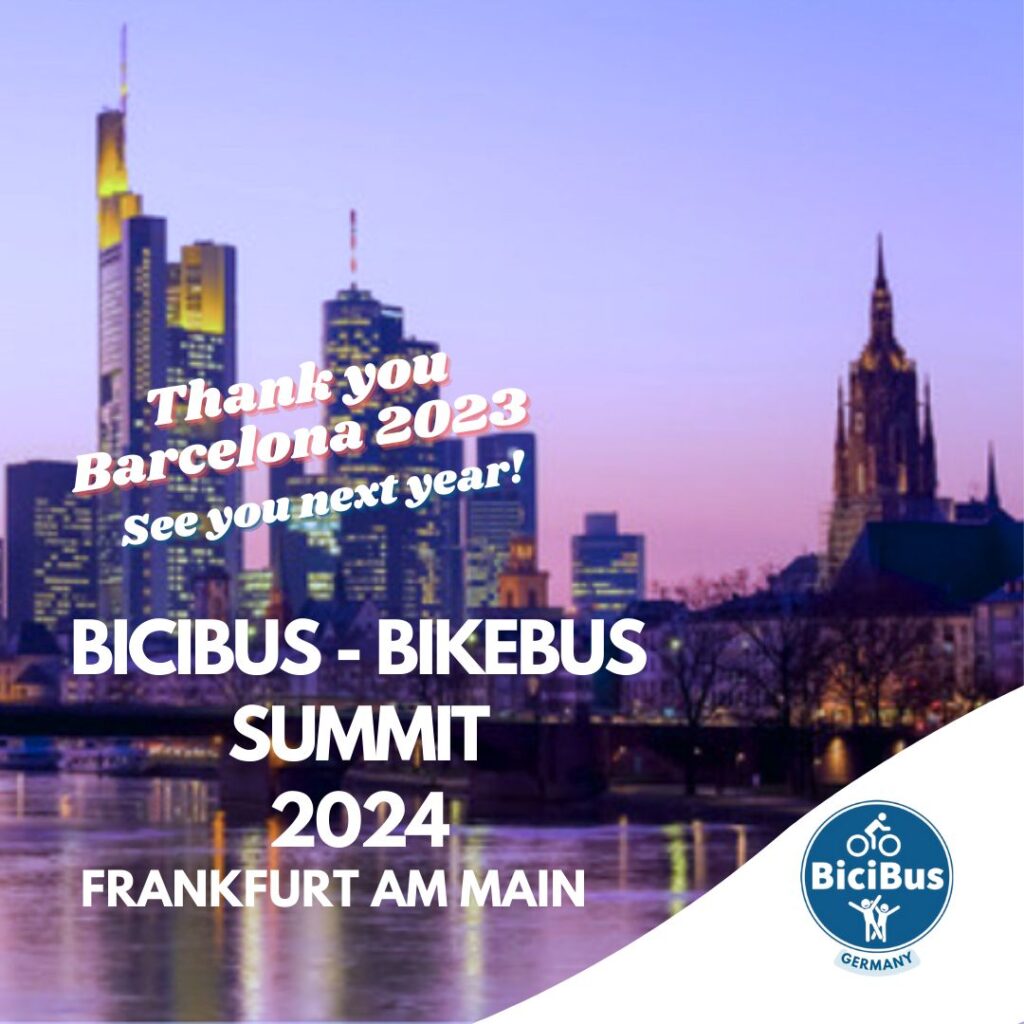
To conclude, perhaps the most important part of the event was simply meeting each other in person. While the explosion of interest in BiciBus can be largely attributed to social media, relationships are consolidated in person. Meeting each other in person, talking about our families and trading Bike Bus anecdotes has cemented a stronger network of Bike Bus activists.
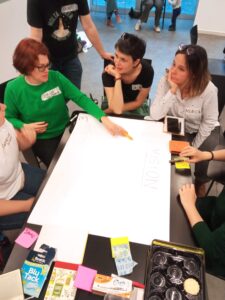
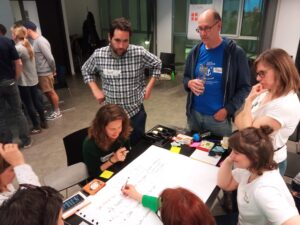
Table 1. Key questions confronting Bike Bus leaders and volunteers discussed at the Bike Bus Summit.
Objectives
- What is driving BikeBus in your community?
- What is our strategy for sustainability?
Organization
- How do you organize your BikeBus?
- How do you mobilize families? How do we motivate children and families?
- How sustainable are bike buses in current (or different) formats?
- What are Bike Bus typologies and modalities?
Support
- What is the level of support we are receiving from the city? from the schools?
Equity & Inclusion
- How can we be more inclusive/equitable? What are the barriers to participation?
Impact
- What is our impact on our kids and adults?
- Are we changing our city?
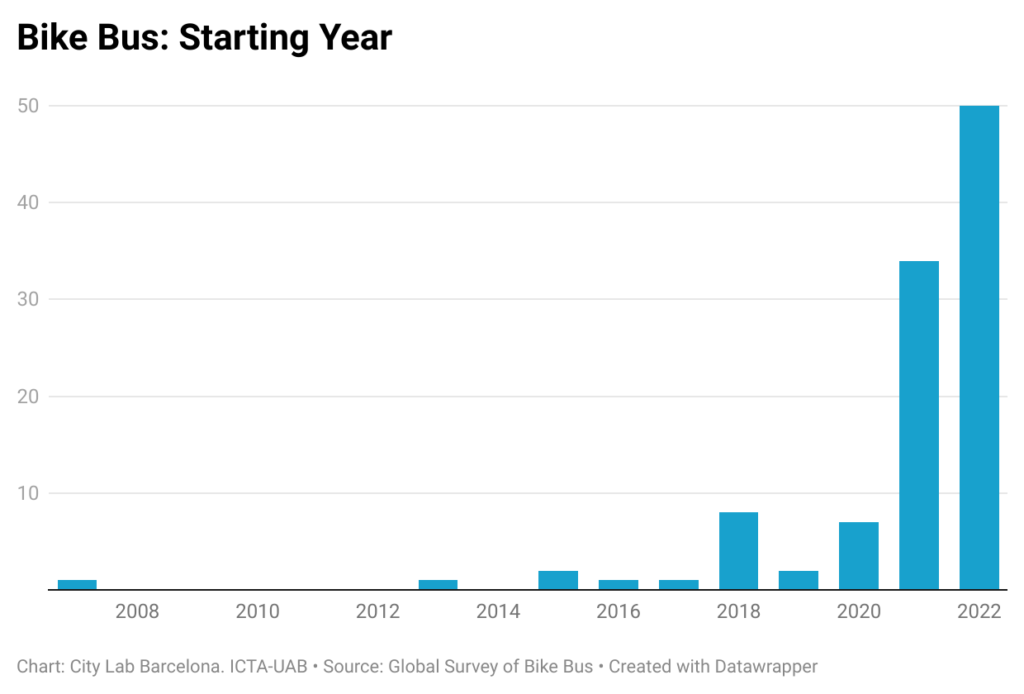



I love the Barcelona Declaration…!
Well done to everyone who attended, and everyone else supporting and participating in bike bus around the world.
🙂👍🏼❤️🚲🛹🛼🛴